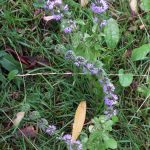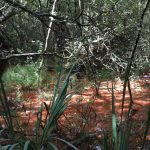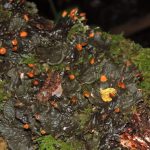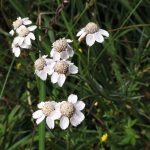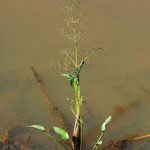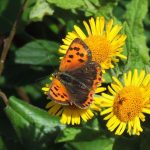Seven members braved the weather forecast of heavy blustery showers and very high winds for a Saturday morning circular walk led by Renée Grayer through Longmoor Bog in California Country Park, Finchampstead. However, the weather turned out much better than expected; we only had two very small showers and even some sunshine. The first stop of the walk was Longmoor Lake, presently full of wild-fowl such as Cormorants Phalacrocorax carbo, Canada Geese Branta Canadensis, Mallards Anas plathyrhynchos, Coots Fulica atra with young chicks and a Moorhen Gallinula chlorepus. Along the lake was a strip of vegetation were the grass was apparently depleted by the Canada Geese and only strong-smelling or tough plants had survived and were even thriving, such as the rare Pennyroyal Mentha pulegium, Common Knapweed Centaurea nigra and Marsh Yellow-cress Rorippa palustris.
A path along the lake led to a wood where only few plants were still in flower apart from Enchanter’s-nightshade Circaea lutetiana. Through a gate we went into the heath land; this is Lowland Heath, which is becoming increasingly rare in Britain. The vegetation here is dominated by Purple Moor-grass Molinia caerulea and several species of tall rushes, such as Soft Rush Juncus effusus, Hard Rush J. inflexus and Sharp-flowered Rush J. acutiflorus. The much smaller Bulbous Rush J. bulbosus showed vivipary; the flowers had developed into new plantlets, each with a bulbil. In between the grasses and rushes were the flowers of Heather Calluna vulgaris, Cross-leaved Heath Erica tetralix, Tormentil Potentilla erecta and Greater Bird’s-foot-trefoil Lotus pedunculatus. Leaves of Bog Pondweed Potamogeton polygonifolius were floating in a small pond and Bottle Sedge Carex rostrata was discovered close by. Tall spikes of the elegant Marsh Thistle Cirsium palustre rose high above the other vegetation.
A second gate led us onto the board walk through Longmoor Bog, a Site of Special Scientific Interest (SSSI), in which the mud and stream are coloured orange. The reason for this is that the water entering the bog is iron-rich and iron bacteria metabolise the metallic ions to colour the water. Water Horsetail Equisetum fluviatile grows abundantly in this bog and so does Alder Alnus glutinosa, some branches covered with moss, algae and lichens, which together with the horsetails give the area a prehistoric feel. One of the lichens was identified as Peltigera membranacea. Here and there were tall leaves of Yellow Flag Iris pseudacorus, flowering plants and leaves of Wild Angelica Angelica sylvestris, Gypsywort Lycopus europaeus in flower and Common Spotted-orchid Dactylorhiza fuchsii and Alder Buckthorn Frangula alnus in fruit. Both Broad and Narrow Buckler-fern Dryopteris dilatata and D. carthusiana are growing here and also Hard Fern Blechnum spicant. At the end of the board walk we saw Small Sweet-grass Glyceria declinata and a large area covered with Bogbean Menyanthes trifoliata.
Through a third gate we came into a wet and flowery meadow, showing Purple-loosestrife Lythrum salicaria, Lesser Spearwort Ranunculus flammula, Slender and Square-stalked St John’s-wort Hypericum pulchrum and H. tetrapterum, Redshank Persicaria maculosa, Jointed Rush Juncus articulatus, Slender Rush J. tenuis, Toad Rush J. bufonius, Lesser Stitchwort Stellaria graminea, Hoary Willowherb Epilobium parviflorum, Marsh Cudweed Gnaphalium uliginosum and Sneezewort Achillea ptarmica. When the sun came out we saw a beautiful Small Copper butterfly Lycaena phlaeas and a number of dragon and damselflies near a pond, of which we only could identify the Common Darter Sympetrum shiolatum with any certainty. Bulrush Typha latifolia and Water-plantain Alisma plantago-aquatica were growing in the pond and we also saw a newt in it, which may have been a Palmate Newt, Triturus helvetica. Earlier a glimpse had been seen of a brown snake-like creature, which may have been a grass snake or a big slow worm. The path led us back to Longmoor Lake and as we still had nearly an hour left of parking, we quickly went round the reserve again to enjoy this unusual heathy and boggy area once more.
Report by Renée Grayer
Pictures by Rob Stallard

